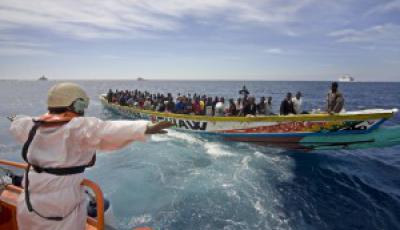The Migrants Files: A Quantitative Approach to Migration Policy
Posted
Time to read
Guest post by Nicolas Kayser-Bril, CEO and co-founder of Journalism++, an agency for data-driven stories. Before founding Journalism++ in late 2011, Nicolas was in charge of datajournalism at OWNI, a Paris-based news startup. A self-taught programmer and journalist, Nicolas holds a degree in Media Economics. You can follow him on Twitter @nicolaskb. Licence: CC-BY-SA-NC 3.0

Data cleaning

What we found out:
- By aggregating sources we showed that the number of dead and missing migrants was 50% higher than previous estimates.
- Mortality rates between migration routes vary widely, from 2 dead per 100 successful journeys in the Canaries to 6 near Malta and Lampedusa. The figures represent the number of deaths along certain routes over the number of detection by Frontex on the same route.
- No EU Member State or EU institution gathers official data on migrants deaths. As one public official put it, dead migrants “aren’t migrating anymore, so why care?”
- As EU Member States constantly close the routes with low mortality, they push migrants towards the more dangerous ones. Under these circumstances, talk of “lives saved” and the security of migration, in which surveillance and push-back activity have been renamed into search and rescue operations, seems little more than a political whitewash.
Beyond numbers

What’s next
We are currently working on a second round of The Migrants Files, to build visual and interactive features that will go beyond body counting and show several angles of the problems. We also aim at refining the data sufficiently to be able to analyse the dangerousness of the journey by country of origin and gender. We’ll engage all the positive responses we received after the first publication round and crowdsource the checking of events and some data cleaning tasks. On the anniversary of last year’s Lampedusa October 3rd shipwreck, we will publish a comprehensive account of what is (and isn’t) being done to improve the safety of migration routes and compare that to the statements issued by officials from the EU and member-states. If you want to help, contact us at debug@themigrantsfiles.com.
For more information about deaths at the border, and the need to count and account for them, see the work in Australia of the Border Crossing Observatory at Monash University.
For a related post about deaths at the US-Mexico border, see Daniel E. Martinez and Robin C. Reineke's (2013) Undocumented Border Crosser Deaths in Southern Arizona.
Any thoughts on this topic? Post a comment here or on our Facebook page. You can also tweet us.
__________
How to cite this blog post (Harvard style):
Kayser-Bril N (2014) The Migrants Files: A Quantitative Approach to Migration Policy. Available at: http://bordercriminologies.law.ox.ac.uk/the-migrants-files/ (accessed [date]).
Share
YOU MAY ALSO BE INTERESTED IN
With the support of









